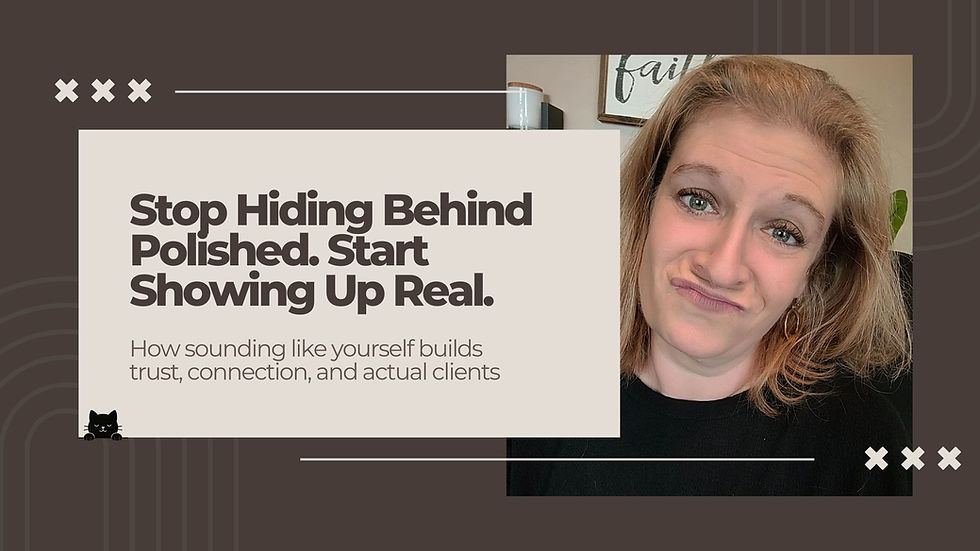Work Smarter, Not Harder: 5 Ways to Simplify Your Business
- Cat Markel

- Dec 2, 2024
- 3 min read

Let’s be honest: when you hear the term “streamlining your business,” does it sound like one of those corporate buzzwords that doesn’t really apply to you? Maybe it conjures up images of flowcharts, spreadsheets, or some kind of high-level strategy session that feels worlds away from the day-to-day hustle of running your coaching or small business.
But here’s the truth: streamlining isn’t just a buzzword—it’s a practical approach to running your business with more ease and efficiency. It’s about removing the bottlenecks, simplifying your processes, and ensuring everything runs smoothly so you can focus on what truly matters: growing your business and serving your clients.
If you’ve ever felt overwhelmed by endless to-do lists or frustrated by inefficiencies, streamlining could be the solution you’ve been searching for. Let’s break it down: What does streamlining even mean? What can you streamline? And how does it differ from automating? Let’s dive in.
What Does “Streamlining” Mean?
Streamlining means simplifying the way your business operates. It’s about cutting out inefficiencies, reducing redundancies, and making sure all the moving parts of your business work together seamlessly. Think of it like decluttering your workspace—but for your business processes. It’s not about doing less; it’s about doing things better.
For coaches and small business owners, streamlining often involves looking at where your time and energy go and figuring out how to maximize them. Are you spending hours every week scheduling clients, chasing invoices, or piecing together social media posts? These are all areas ripe for streamlining.
What Can You Streamline in Your Business?
The beauty of streamlining is that it can apply to almost every aspect of your business. Here are some key areas to consider:
1. Client Management
Scheduling appointments, sending reminders, and keeping track of client notes can be overwhelming. Tools like a CRM (Customer Relationship Management system) can keep everything organized in one place.
2. Marketing
From creating consistent branding to scheduling social media posts, marketing can feel like a full-time job. Streamlining here means creating templates, using scheduling tools, and having a clear plan.
3. Administrative Tasks
Invoicing, contract management, and email follow-ups are necessary but time-consuming. Systems like automated invoicing tools and email templates can make these tasks quicker and easier.
4. Workflows
Whether it’s onboarding a new client or delivering a service, having a clear, repeatable process ensures nothing falls through the cracks.
5. Communication
Are you juggling emails, texts, and DMs across platforms? Consolidating communication into one platform can save you hours every week.
Tools to Help You Streamline
The right tools can make streamlining almost effortless. Here are a few favorites:
CRM Tools: Organize client information, track interactions, and manage tasks. Examples: Dubsado, HoneyBook.
Scheduling Tools: Let clients book appointments themselves, sync with your calendar, and send reminders. Examples: Calendly, Acuity.
Social Media Management Tools: Plan, schedule, and analyze your social media posts. Examples: Buffer, Later.
Invoicing Tools: Automate payment reminders and create professional invoices. Examples: QuickBooks, Wave.
Workflow Automation: Tie everything together and ensure tasks move smoothly. Examples: Zapier, Asana.
Pro tip: Many of these tools are part of my Coach's Mastery Suite and Business in a Box packages, which bundle everything you need to streamline your business into one easy-to-use system.
Streamlining vs. Automating: What’s the Difference?
Here’s where things can get a little confusing, so let’s clear it up. While streamlining and automating often go hand in hand, they’re not the same thing.
Streamlining is about improving the process. It’s the strategy behind making your workflows simpler and more efficient. For example, creating a clear onboarding checklist for new clients is streamlining.
Automating is about letting technology handle repetitive tasks. It’s the execution of your streamlined processes. For instance, using an email tool to send your onboarding checklist to new clients automatically is automation.
Streamlining is the foundation—it ensures your processes make sense. Automation takes it to the next level by saving you time and effort.
How Streamlining Benefits Your Business
Let’s talk about the why. Here’s what streamlining can do for you:
Save Time: Less time on repetitive tasks means more time for your clients and creative work.
Increase Revenue: Efficiency leads to better client experiences, which translates to referrals and repeat business.
Reduce Stress: When your business runs smoothly, you can focus on what matters most.
Boost Confidence: Knowing your systems are solid gives you the freedom to grow your business without fear of things falling apart.
Ready to Simplify?
Streamlining doesn’t have to feel overwhelming. Start small—pick one area of your business to simplify, and go from there. Need help figuring out where to start or what tools make the most sense for you? That’s what I’m here for.
Let’s chat about how we can streamline your business together—so you can spend less time on the back end and more time doing what you love.





Comments